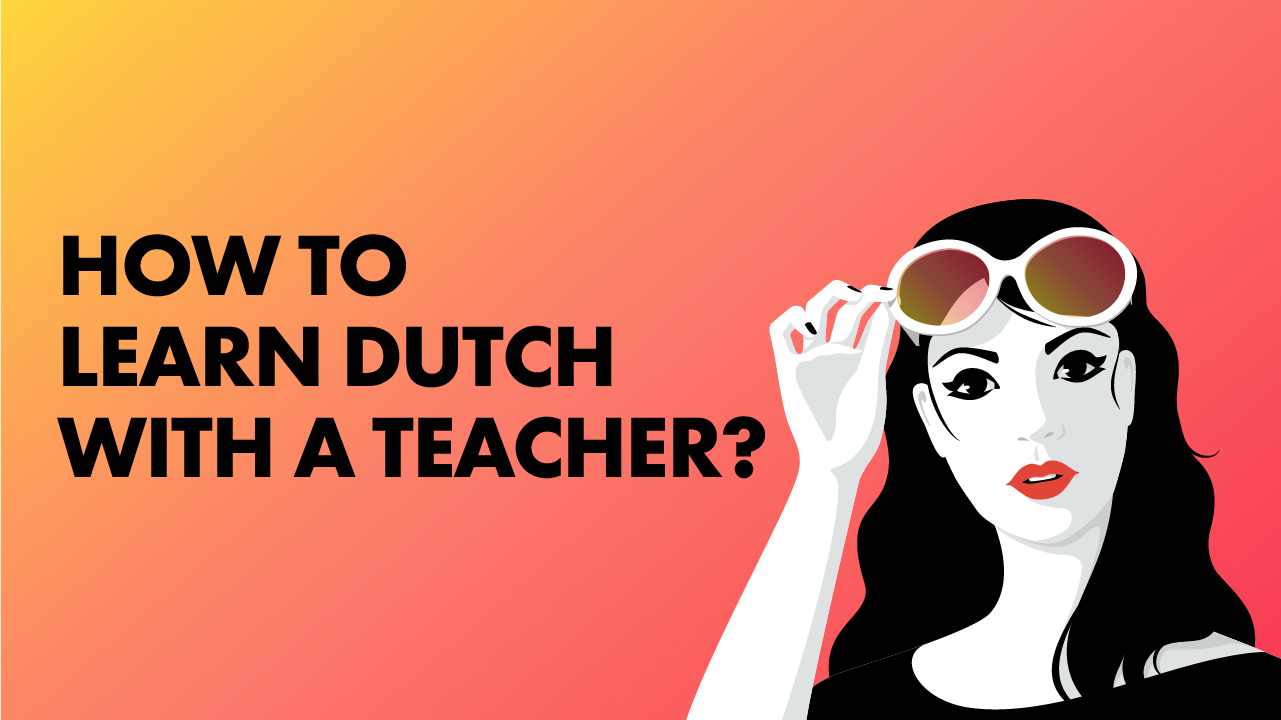So you want to learn Dutch? We’ve been there too. This is how the Taalhammer project started.
We met in Amsterdam with an old friend of mine and we both wanted to learn Dutch. We had both learnt languages before, so we already had some good experience. This time, however, we experimented with some well-known memory-hacking techniques and a bit of software engineering. It all worked like a charm.
Collaboration tool
Language learning is 80% working solo and 20% working with your teacher. Taalhammer supports you in both.
You can learn a lot with Taalhammer just on your own (there is a separate video on that), but we highly recommend finding a teacher. Teachers play a crucial role in the process of language learning. They talk with you, they correct your pronunciation, and most importantly they keep your motivation high.
If you already have a teacher, then he/she probably already overwhelms you with PDF files, Google Docs, or chat messages. Taalhammer solves that problem for you.
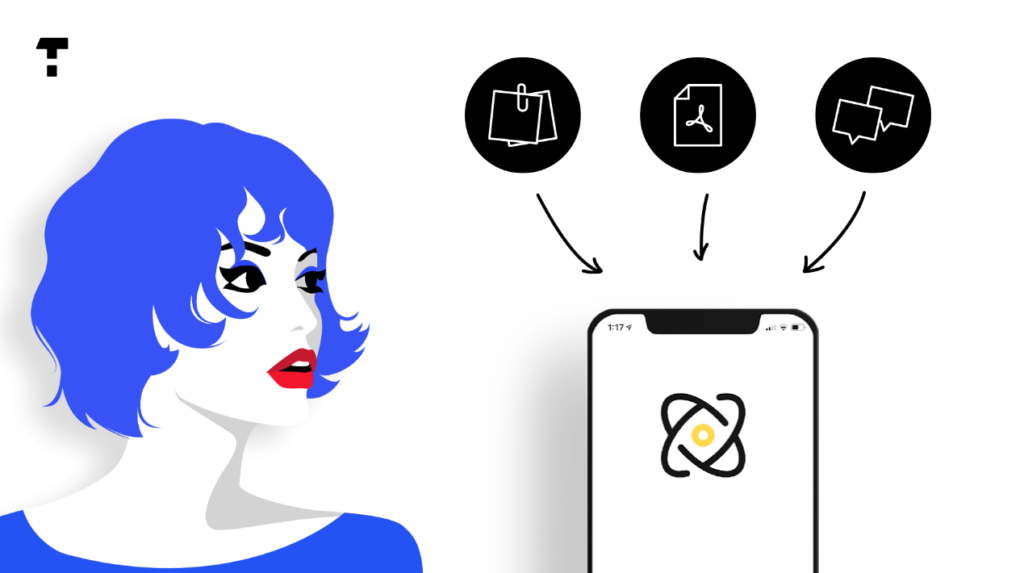
Teachers can easily add more words and sentences to your learning stream. Taalhammer will make sure you learn them all in the most optimal way. That way everyone can focus on their task. You can focus on practice and repetitions.
A collection is a place where you store two types of content:
- chunks of language – all the things that you need to memorize and automate (i.e. words, phrases, and sentences).
- all the other supporting material (i.e. links, texts, videos, comments and other notes).
During the lesson, you typically work with your teacher on the Taalhammer Board. The teacher simply needs to share their screen with you and start making notes on it. All language chunks from the lesson will be added to your learning and scheduled for repetitions.
Collection types
There are several types and sources of collections.
First you have Dutch core collections, which have carefully curated content optimized for building and strengthening speaking skills in the most fundamental part of the language.
Second are the collections that come from your teachers. They will contain content from your classes, and they are much easier for you as you already have some context and emotional connection to their content.
Lastly, we are continually adding topic collections (like “COVID-19” or “love and flirting), so you can expand your vocabulary and learn about things interesting for you.
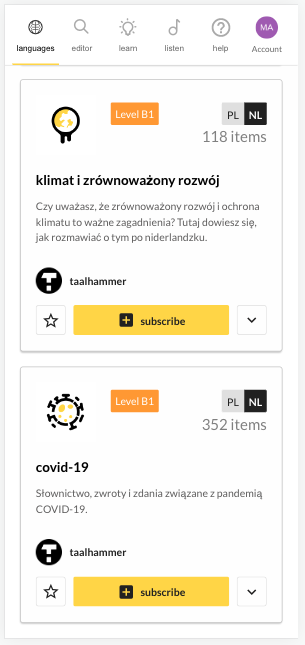
Not only a collaboration tool
Taalhammer is not only a great collaboration tool.
Its true power comes from the combination of the collaboration features with what you’ll be learning and how. Thanks to our algorithm, you can easily remember thousands of simple sentences.
With each remembered sentence, your brain is coding patterns and saving language chunks. Add questions and negations to the mix and you’ll be able to hold a conversation. Change the tense/time to the future or the past, and more often than not you’ll know how to say something without knowing a grammar rule behind it, just like we all do in our native languages.
When looking for a collection, in our catalogue you can filter them by various attributes. If you are part of a language school that works with Taalhammer (like the Amsterdam-based Koentact), your teachers’ collections will be available on a filter named for your school.
If the content provided by your teacher is not enough, subscribe to one of our core or topic collections. Go to the collection catalogue and make sure your target language is set to Dutch. Now find a collection that corresponds to your level and subscribe to it.
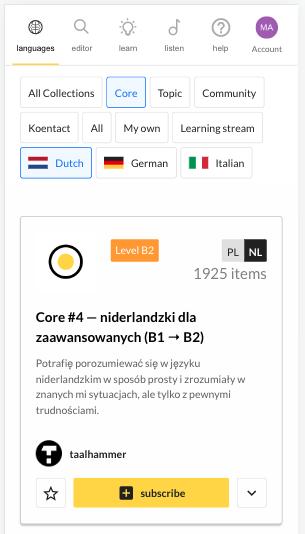
Even if you’re on an intermediate level like B1 or B2, we recommend you go through the core collections. It will give you speed, fluency, and confidence in the most fundamental areas of the Dutch language.
Keep in mind that if you subscribe to multiple collections at the same time, the content served to you will be coming from all these collections. It may seem chaotic or without a context at times. If the content served to you is too easy or too hard, you can always change your subscribed collections.
In learning mode, if a word or a sentence seems to be strange or irrelevant, just click the trash icon and Taalhammer will never bother you with this content again.
Core Collections
So, what does learning with sentences in the core collection look like?
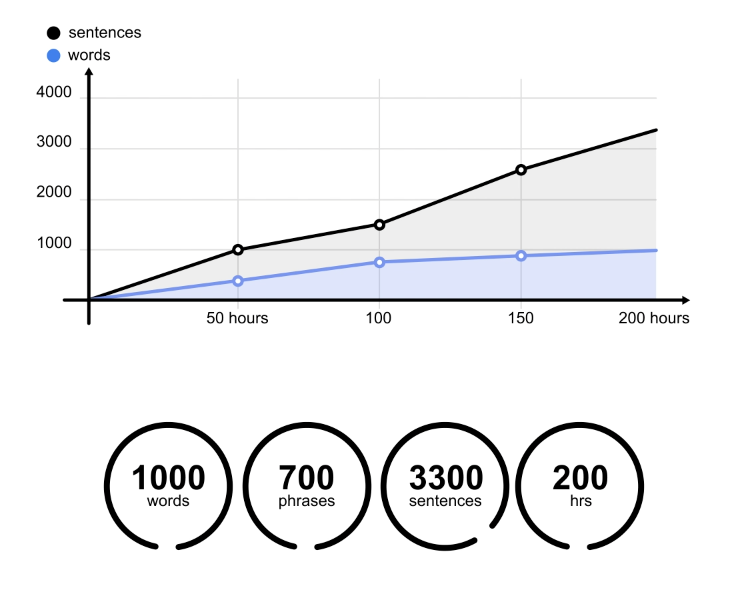
You will learn a few words and then we will teach you sentences with those words. While we increase the new words slowly and steadily, the number of sentences increases rapidly. The sentences are mostly variations of themselves: questions, answers, negations, etc. After around 200 hours spent on repetition, you’ll know 1000 words, 700 phrases, and 3300 sentences.
A good analogy to help you think about this is music. You can view words like musical notes. The various phrases and sentences you use can be viewed as musical scales. By practicing a small set of musical scales, you can open yourself up to playing a huge number of songs.
Why should you learn with whole sentences?
Take a look at those examples:
- I go to the gym.
- She goes to the gym.
- She goes to the park.
- She does not go to the park.
- We went to the park.
- We didn’t go to the park.
- We didn’t go there.
You need to learn them by heart. It does not matter if you actually go to the gym or not. It’s popular enough to be worth learning. Not only because of the fact that many people do go to the gym and you’ll hear that quite often. It’s extremely important because it contains different forms of the verb “to go“, which is one of the most frequent and important verbs and we use it all the time. You constantly talk about going somewhere — in the past, now and in the future. If you want to communicate fluently you have to automate the usage of these verbs in conjunction with places and across tenses and persons.
This approach gives even more spectacular results with typical language troublemakers like temporal expression and conditional sentences.
- She looks healthy.
- She will look healthy.
- If she goes to the gym, she will look healthy.
- If she went to the gym regularly, she would look healthy.
- If we went to the swimming pool regularly, we would look healthy.
- When we were healthy, we were going to the swimming pool more.
Learning with sentences enables you to get a feeling for how to speak correctly. If you work that way, you will feel the progress week by week. The constant progress will be your motivation to keep going in your marathon.
Start learning Dutch now on taalhammer.com

